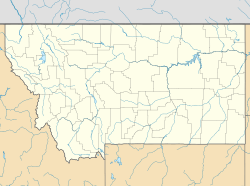Petroglyph Canyon facts for kids
Quick facts for kids |
|
|
Petroglyph Canyon
|
|
| Location | Southern half of Section 35, Township 9 South, Range 26 East |
|---|---|
| Nearest city | Warren, Montana |
| Area | 160 acres (65 ha) |
| NRHP reference No. | 75001079 |
| Added to NRHP | November 20, 1975 |
Petroglyph Canyon is a special place in the northwestern United States. It's important for archaeologists, who study old things. This canyon is found right on the border between Montana and Wyoming. Even though it's not very big, it's super important! It became famous in the 1900s because of the many ancient petroglyphs (rock carvings) found there. Because of these amazing carvings, a large part of the canyon was made a historic site in the 1970s.
About the Canyon's Rocks
The most important part of Petroglyph Canyon is in southern Carbon County, Montana. The whole canyon stretches for about 4 miles (6.4 km) from northwest to southeast. It starts in Montana and goes about 2.5 miles (4 km) into Big Horn County, Wyoming.
The walls and large rocks in the canyon are mostly made of sandstone. Over time, the weather has turned these rocks a dark brown color. But if you look under the surface, the stone is a lighter tan.
Amazing Rock Carvings
A section of the canyon, about 800 feet (240 meters) long, is filled with many ancient petroglyphs. These carvings are found on the canyon walls and on large boulders. Scientists have found at least eighteen different groups of carvings. There are also other interesting things like old hearths (fire pits) and small pieces of stone. These stone pieces were left behind when people made stone tools a long time ago.
Most of the petroglyphs were made by "pecking" tiny holes into the rock. This means people used a harder stone to tap out small bits of the rock surface. However, one group of carvings was made by "engraving" lines into the stone.
Most of the designs in Petroglyph Canyon show humans or large animals. You can see bison (buffalo) and bighorn sheep. Some carvings clearly show men or women. Some of the carvings are so old that they have started to turn the same dark color as the surrounding rock. This shows just how ancient they are! Most of the carvings, though, still look very clear.
A few designs at the site, like personal names, were added much more recently by people who didn't respect the ancient art. But these newer carvings are rare. They were usually placed near older designs, not on top of them.
Why This Canyon is Special
Petroglyph Canyon got its current name in 1967. That's when archaeologists first found and studied the carvings. Before that, the canyon appeared on maps, but it didn't have a name. The name "Petroglyph Canyon" was first officially used in 1975. That's when the canyon was added to the National Register of Historic Places. This is a list of places in the United States that are important to history.
Since then, groups like the Bureau of Land Management and the United States Forest Service have used this name. Local people also use it. In 1992, the United States Board on Geographic Names officially gave the canyon its current name.
The canyon was added to the National Register because it's a very important archaeological site. Even though some people have damaged parts of it, the site is still incredibly valuable. Petroglyph sites are found all over Montana. However, sites made by "pecking" (like many in this canyon) are much rarer in Montana than in states like Wyoming or Utah. Petroglyph Canyon has a wider variety of artwork and less damage than almost any other rock art site in Montana.
When the site was listed, archaeologists hoped to study it more. They wanted to compare it to other rock art sites nearby. The styles of art in Petroglyph Canyon are more like those found at faraway sites than at other nearby ones. By comparing these sites, scientists hope to learn about how ancient people moved around and where they traveled.
- Francis, Julie E., and Lawrence L. Loendorf. Ancient Visions: Petroglyphs and Pictographs from the Wind River and Bighorn Country, Wyoming and Montana. Salt Lake City: U of Utah P, 2002.



